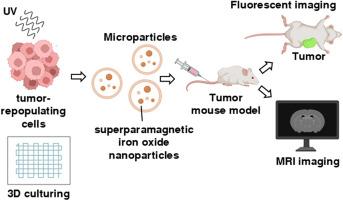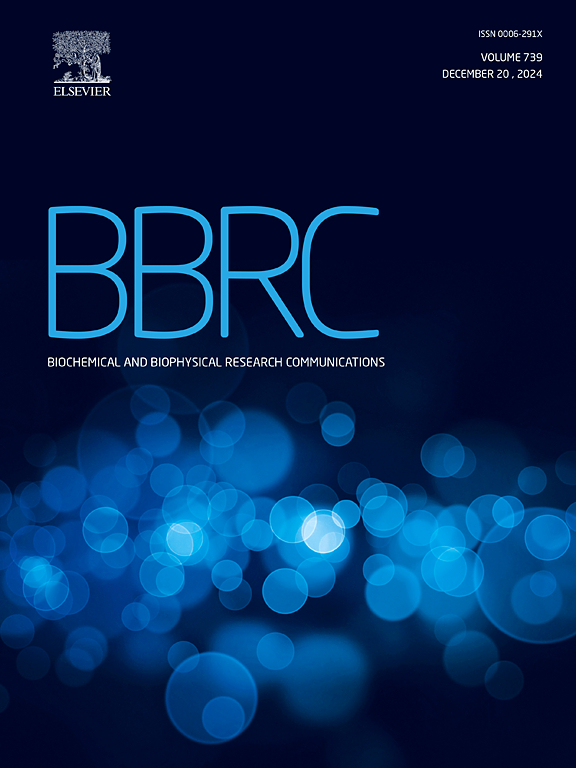UV radiation enhanced encapsulation of superparamagnetic iron oxide nanoparticles (MNPs) in microparticles derived from tumor repopulating cells
IF 2.5
3区 生物学
Q3 BIOCHEMISTRY & MOLECULAR BIOLOGY
Biochemical and biophysical research communications
Pub Date : 2024-11-22
DOI:10.1016/j.bbrc.2024.151050
引用次数: 0
Abstract
Extracellular vesicles (EVs) such as microparticles secreted by the cells can be manipulated and used for delivering therapeutic drugs to target and eradicate cancer cells. However, high encapsulation efficiency and mass production of the microparticles remain difficult to achieve. Efficient and targeted delivery to cancer cells is another hurdle to be addressed. To overcome these issues, we integrated superparamagnetic iron oxide nanoparticles (MNPs) with microparticles. First of all, exposure of highly aggressive tumor-repopulating cells (TRC) to UV radiation dramatically improved microparticle production. These TRC cells were selected from diverse cancer cell lines that are 3D culturing in soft fibrin gel. These microparticles derived from 3D-cultured TRCs have lower membrane stiffness than 2D-cultured cells. Ferrozine assay showed that endocytosis and encapsulation of MNPs during microparticle production were higher in 3D-cultured TRC cells than in 2D cultured cells. Packaging of MNPs into microparticles also enhanced cellular uptake of MNPs without inducing cytotoxicity to treated cells. Compared to the naked MNPs, ex vivo fluorescence imaging shows that mice tail-vein injected with microparticle-encapsulated MNPs displayed continuous increments of intratumoral accumulation of MNPs. Furthermore, MRI images revealed a higher T2 contrast and an uneven distribution of the T2 contrast in the tumor of mice tail-vein injected with microparticle-encapsulated MNPs than naked MNPs. This study provides a new platform for cancer imaging by integrating MNPs and microparticles derived from tumor-repopulating cells.

紫外线辐射增强了超顺磁性氧化铁纳米粒子(MNPs)在源自肿瘤再增殖细胞的微颗粒中的封装能力
细胞外囊泡(EVs),如细胞分泌的微颗粒,可被操纵和用于递送治疗药物,以靶向消灭癌细胞。然而,高封装效率和微颗粒的大规模生产仍然难以实现。向癌细胞高效、定向地递送药物是另一个需要解决的障碍。为了克服这些问题,我们将超顺磁性氧化铁纳米颗粒(MNPs)与微颗粒相结合。首先,将具有高度侵袭性的肿瘤增殖细胞(TRC)暴露于紫外线辐射下可显著提高微颗粒的生成。这些TRC细胞是从在软纤维蛋白凝胶中进行三维培养的各种癌症细胞系中挑选出来的。与二维培养的细胞相比,三维培养的TRC细胞产生的微颗粒具有更低的膜硬度。铁嗪试验表明,三维培养的 TRC 细胞在生成微颗粒的过程中,MNPs 的内吞和包裹能力高于二维培养细胞。将 MNPs 包装成微颗粒还能提高细胞对 MNPs 的吸收,而不会对处理过的细胞产生细胞毒性。与裸露的 MNPs 相比,体内外荧光成像显示,小鼠尾静脉注射微粒封装的 MNPs 后,MNPs 在瘤内的积累不断增加。此外,核磁共振成像图像显示,与裸MNPs相比,注射微粒包囊MNPs的小鼠尾静脉肿瘤的T2对比度更高,且T2对比度分布不均。这项研究通过整合 MNPs 和来自肿瘤繁殖细胞的微颗粒,为癌症成像提供了一个新平台。
本文章由计算机程序翻译,如有差异,请以英文原文为准。
求助全文
约1分钟内获得全文
求助全文
来源期刊
CiteScore
6.10
自引率
0.00%
发文量
1400
审稿时长
14 days
期刊介绍:
Biochemical and Biophysical Research Communications is the premier international journal devoted to the very rapid dissemination of timely and significant experimental results in diverse fields of biological research. The development of the "Breakthroughs and Views" section brings the minireview format to the journal, and issues often contain collections of special interest manuscripts. BBRC is published weekly (52 issues/year).Research Areas now include: Biochemistry; biophysics; cell biology; developmental biology; immunology
; molecular biology; neurobiology; plant biology and proteomics

 求助内容:
求助内容: 应助结果提醒方式:
应助结果提醒方式:


